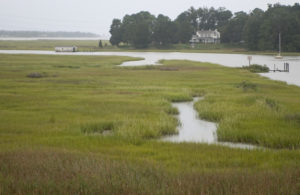Estuaries — Working for Anglers and All Americans
For Habitat Month 2019, NOAA is celebrating estuary habitat and how we work for you, from the Chesapeake Bay to the Oregon Coast.
from The Fishing Wire

Chesapeake Bay estuary
Chesapeake Bay estuary
Estuaries, where rivers meet the sea, provide valuable habitat to an array of important plant and animal species. These transitional areas that straddle land and sea contain habitats needed by fish, shellfish, wildlife, and people. For humans, they provide homes, jobs, and value: estuaries generate an estimated $12 billion in revenue each year from tourism and local economies. Most fish and shellfish eaten in the United States, including salmon, herring, and oysters, spend at least part of their life in estuaries. NOAA works within several U.S. estuaries including, but not limited to, the following:
Puget Sound, Washington
Columbia River, Oregon
Kachemak Bay, Alaska
Narragansett Bay, Rhode Island
Delaware Bay Estuary, Delaware
Chesapeake Bay (DE, MD, NY, PA, VW, WV and DC)
Albemarle-Pamlico Sound, North Carolina
Tampa Bay, Florida
Galveston Bay, Texas
For Habitat Month, NOAA is celebrating estuary habitat and how we work for you, from the Chesapeake Bay to the Oregon Coast. Learn more about how NOAA is restoring and protecting some estuary habitat below.
Estuary Highlights
Oregon Coastal Habitat Project Restores Coho and Reduces Flooding
The Southern Flow Corridor project, which restored salmon habitat in Tillamook, Oregon, also provides flood protection for surrounding communities. Learn more about NOAA’s work with community partners restoring estuary habitat in Tillamook Bay
Juvenile coho salmon use estuaries to eat and grow before migrating to the ocean. Photo: USFWS/Roger Tabor
Skokomish River Estuary Restoration Helps Salmon and Steelhead Return Home
In the Puget Sound region, reopening abandoned agricultural land back to nature will allow young salmon, steelhead, and other fish species room to access their historical habitats. Learn more about the Skokomish River Estuary restoration project
NOAA works with our federal and state partners to recommend pollution control and cleanup strategies and develop and implement restoration projects, such as marsh creation and dam removals, to benefit fisheries, wildlife and the public.Learn more about the Hudson-Raritan Estuary
NOAA and the Chesapeake Bay Program
To identify and implement solutions for the Chesapeake Bay, the Chesapeake Bay Program was formed in 1983. The dozens of partners in the Chesapeake Bay Program include federal and state agencies, local governments, nonprofit organizations, and academic institutions. Each organization brings unique knowledge, capabilities, and perspectives to this tremendous partnership. NOAA is represented in the Chesapeake Bay Program by the NOAA Chesapeake Bay Office, a division of NOAA’s Office of Habitat Conservation. Learn more about the Chesapeake Bay Program
The Chesapeake Bay Program has set a goal to restore native oysters to 10 Chesapeake Bay tributaries by 2025.
Habitat Focus Areas
Between 2013 to 2015, NOAA selected 10 Habitat Focus Areas. These are places where multiple NOAA offices can effectively focus their resources to prioritize long-term habitat science and conservation efforts. In each of these areas, our science, service, and stewardship come together to improve habitat conditions for fisheries, coastal communities, and marine life, and to provide other economic, cultural, and environmental benefits our society needs and enjoys. Explore NOAA’s Habitat Focus Areas